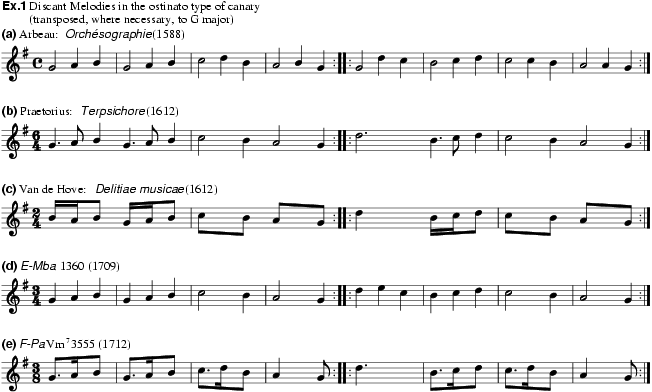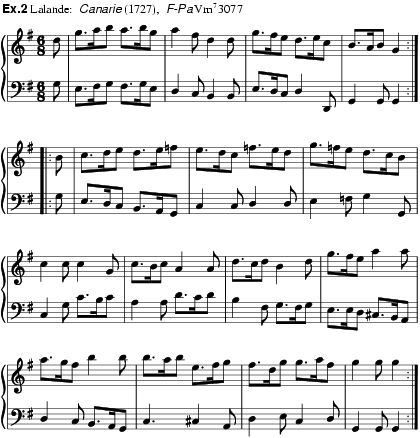
(Fr. canarie; It., Sp. canario).
A form of dance and music popular in Europe from the mid-16th century to the mid-18th. Two main types of music existed, an early Spanish and Italian canario and the later French canarie.
Covarrubias Horozco described the canario in his Tesoro de la lengua castellana o española (1611) as a type of ‘saltarelo gracioso’ that came to Spain from the Canary Islands. A piece called Endechas de canaria appeared in Pisador’s vihuela book of 1552, and the dance was mentioned by Diego Sánchez de Badajoz in the Farsa de Sancta Bárbara (published in his collected works of 1554), and by Cervantes, Lope de Vega and many other Spanish writers throughout the 17th century. Discussing its origins and character, Arbeau (Orchésographie, 1588) noted that its ‘passages are gay but nevertheless strange and fantastic with a strong barbaric flavour’.
This earlier canary often employs a short, two-phrase scheme that is relatively fixed melodically and harmonically (ex.1). Both phrases have the same harmonic progression (I–IV–I–V–I, also used by the Spanish saraband, the villano and the passamezzo moderno, or sometimes simply I–IV–V–I) and, in some cases, almost the same melody. The two phrases, each usually made up of four triple beats, are alternated and repeated in various ways, producing a strong sense of ostinato. Cesare Negri, in Le gratie d’amore (1602/R, 2/1604 as Nuove inventioni di balli), accompanied his description of the canary’s choreography with music much like ex.1b, but with the C in each phrase harmonized with a VII chord instead of IV. Caroso gave examples in Il ballarino (1581/R) and Nobiltà di dame (1600) somewhat like those in ex.1, providing a choreography for the canary by itself, as well as appending one at the end of several groups of dances. It is a ‘fiery wooing dance’ with ‘rapid heel-and-toe stamps’ and ‘noisy sliding steps’ (Sutton, 1998). Shakespeare seems to refer to such a choreography in his Love’s Labour’s Lost and All’s Well that Ends Well.

Other music examples, some of which differ from ex.1, appear in the Moresca deta le canarie of Barbetta (1585) and a Canario spagnuolo (manuscript, I-Lg 774) for lute, canaries for ensemble by Allegri (1618), Zannetti (1645), and G.B. Vitali (1667), and examples from 1606 to 1677 for the five-course guitar. In Spain the canary appeared in the guitar books of Sanz (1674), Ruiz de Ribayaz (1677), Guerau (1694) and Santa Cruz (manuscript, E-Mn 2209), and still survives as a folksong.
The French canarie is in 3/8 or 6/8 time and is made up of four- and eight-beat phrases with beats using the ‘sautillant’ figure (ex.2). Some canaries have an upbeat but most do not. Their music has no fixed melody or harmony and may be major or minor, with the free sectional structure common to most late Baroque dances (usually two repeated sections, with a variable number of bars in each). Several 18th-century writers (Walther, Musicalisches Lexicon, 1732; Mattheson, Der vollkommene Capellmeister, 1739) described the canary as a fast gigue.

The canary became popular in France from the 1660s when Lully first used it in his court ballets (Ballet des Gardes, Act 3; Ballet de Flore, Act 15; Ballet des Muses, Act 4; Le bourgeois gentilhomme, Act 1 scene i). It became one of the optional dances of the suite, appearing in compositions for solo lute (Bouvier, Denis Gaultier) and clavecin (Chambonnières, Louis Couperin, Lebègue); later it was included in ballets and operas by, for example, Campra, Destouches, Lalande, Collasse and La Coste. German composers (Gottlieb Muffat, J.C.F. Fischer, Kusser, Telemann) used it in suites for keyboard, small ensemble and orchestra, as did English composers including Purcell.
11 choreographies, including three by English choreographers, are extant in the Beauchamp-Feuillet notation (Little and Marsh). Most are difficult theatre dances employing virtuoso steps such as cabriolets. Canaries often appeared in pairs, for example in Lully's Bellérophon (1675, Act 5 scene iii; Little and Marsh, no.1320).
E. Cotarelo y Mori: Colección de entremeses (Madrid, 1911), pp.ccxxxvi–ccxxxvii
J. Pulver: Dictionary of Old English Music (London, 1923), 27–9
M. Querol Gavaldá: La música en las obras de Cervantes (Barcelona, 1948), 99–101
M. Dolmetsch: Dances of Spain and Italy from 1400 to 1600 (London, 1954), 52–73 [the music on pp.63–4 is not from Negri’s book]
L.H. Moe: Dance Music in Printed Italian Lute Tablatures from 1507 to 1611 (diss., Harvard U., 1956), 66–7, 270–78, 458
M. García Matos: ‘Viejas canciones y melodías en la música instrumental popular de las danzas procesionales practicadas aún en España’, Miscelánea en homenaje a Monseñor Higinio Anglés, i (Barcelona, 1958), 289–90
M. Nelson: ‘Canarios’, Guitar Review, no.25 (1961), 18–22
M. Ellis: The Dances of J.B. Lully (1632–1687) (diss., Stanford U., 1967), 89–94
W. Hilton: Dance of Court and Theater (Princeton, NJ, 1981)
B. Bang Mather: Dance Rhythms of the French Baroque: a Handbook for Performance (Bloomington, IN, 1987), 221–4
M. Little and C. Marsh: La danse noble: an Inventory of Dances and Sources (Williamstown, MA, 1992)
J. Sutton and F.M. Walker, eds.: Courtly Dance of the Renaissance (New York, 1995; Eng. trans. of F. Caroso: Nobilità di dame, 1600)
J. Sutton: ‘Canary’, International Encyclopedia of Dance (New York, 1998)
RICHARD HUDSON/MEREDITH ELLIS LITTLE